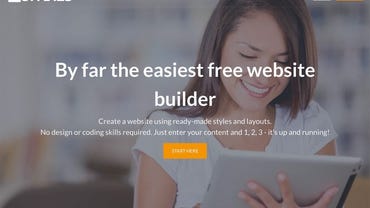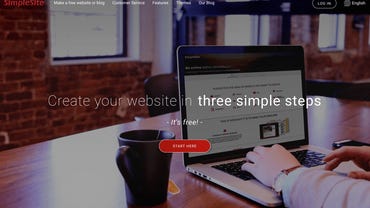There are plenty of good reasons to build your own personal website. Perhaps you’d like to share archival photos and documents with friends and family members, exhibit your prized baseball card collection, publish a novel, or simply blog about your life and travels. These are all good motivators to sign up for a reliable and reasonably priced web content-management toolset.
Beyond the free “personal” web pages offered by Facebook, LinkedIn, Instagram, Twitter, and other social networks — in which your personal information becomes part of the network’s lingua franca — there are several excellent yet free or inexpensive web services that offer alternative ways to establish your own internet stake in the ground. These website-building products enable users to design, provision, and maintain a personal website in minutes or hours, depending upon how much time and effort one chooses to spend on the project.
Working with a website builder is relatively easy because they offer a what-you-see-is-what-you-get editing interface — meaning what you see. At the same time, you edit your site is what you will actually see if your website was live and viewed in a browser. The best website builders are rich in features that include professionally designed website templates, easy-to-use, drag-and-drop editors, and onboard hosting services.
Chief criteria used for this list include
- Intuitive usability (easy-to-follow instructions and performance)
- Ease of design (drag and drop controls, wizards, pre-built templates)
- A domain name included
- Professional email
- Mobile device-readiness
- Security options
- Special features (is it commerce-ready?)
- Optimization for search engines
Some of these listed services will have all of the above; some will miss one or more of these but may offer other features.
See more: ZDNet’s list of best e-commerce site builders
Wix
Best free website builder

One thing that comes out clearly in research here is that Wix is a head-and-shoulders No. 1 by acclamation of the resources we used. Wix is an intuitive-to-use site builder with hundreds of page templates — most of which are attractively designed — drag-and-drop elements, easy-to-follow wizards, and a menu of helpful widgets.
For people looking to get a website online with minimal effort and maximum creative freedom, Wix should be one of your test choices. No coding or FTP knowledge is required. All a user needs is an email address to get started with Wix’s web hosting. If you don’t mind ads, you can publish a site free of charge for as long as you like. It’s that way with all the free sites.
Wix offers total creative control in that you can drag anything, anywhere. It also offers online storage for site assets, e-commerce tools, useful video backgrounds, and title animations. Wix’s new Editor X interface is intuitive to use and respected in the highly competitive field of website-building services. In summary, Wix is a simple-to-use, multi-faceted tool that is well worth a test drive–whether for its free or paid versions.
Wix’s most important features:
- Intuitive Editor X interface.
- Many optional widgets.
- Hundreds of templates for specific businesses and other uses.
- Good mobile-site-building tools.
- Rich web-store features.
- Excellent uptime and customer service support.
- Many commerce options, including the ability to sell digital downloads.
- Free version option.
Wix pricing plans: Basic: no cost, ad-supported; Combo account (3GB of storage and 2GB of monthly data transfers), $14 per month; VIP plan (35GB of storage, a domain name, unlimited monthly data transfers, a professional logo, and priority support), $39 per month.
Business sites with shopping carts and other features go for between $23 and $49 per month.
Enterprise-level plans require consultation with Wix and start at $500 per month. For details, go here.
WordPress
Established high quality based on open source

WordPress is by far the most utilized internet content management system in the world, powering 37 million sites — about 40% of all websites in 2021, according to market analyst Kinsta and researcher Netcraft. WordPress also owns a commanding 60.8% share of the CMS market; Digital.com reports that it powers 30% of the world’s top 1000 websites.
Since its founding in 2003, the open source-based WordPress provides hosting for more than 500 sites built each day somewhere in the world. WordPress’s Plugin Directory features 54 000+ free plugins; its WooCommerce version powers 22% of the world’s top 1 million e-commerce sites. The main reasons why so many people put WordPress to work are simplicity in usability, its free option and generally low cost, and numerous features, mostly from the open-source community.
The term “WordPress” is often used interchangeably when referring to two software variations. There are significant differences between WordPress.com and WordPress.org that you’ll want to know before picking the platform for your project. WordPress.org is an open-source content management system, while WordPress.com is a popular blogging platform with basic functionality that can be accessed free of charge.
WordPress is available in 196 languages, far more than other competitors.
WordPress’s most important features:
- Simple-to-use editing interface.
- A forgiving design system that preemptively identifies and notifies users of mistakes.
- A large number of optional widgets.
- Online storage for web assets.
- Hundreds of templates for specific businesses and other uses.
- Free version option and other modestly priced versions.
*Be advised that some coding is required for the upper-level editions.
WordPress pricing and monthly plans: Basic: no cost; all others go for between $5 and $100 per month, depending upon features and hosting options.
Site 123
An alternative to consider for making a fast and clean-looking site.

Site 123 is a rising developer-created website builder with about 5 million users that wants to be the easiest-to-use platform now available for do-it-yourselfers. Of course, lots of services make the same claim, but Site123 deigns to prove their point with an easy-to-use interface and templates.
Site 123 is best for building a small, quick website on a premade template, and it has a generous free plan along with straightforward onboarding and web design options.
Instead of operating like a traditional drag-and-drop website builder, Site123 has users pick their preferences and customize a curated template based on that niche, which appeals to beginners with no design or development experience.
Site 123 does have limited design and technical features and doesn’t offer a lot of customer support. Again, if you’re keeping it simple, these caveats aren’t a problem.
Site 123’s most important features:
- Provides all the basics someone needs to get started.
- No-frills design and layout promote fast development.
- An adequate number of easy-to-use templates.
- Free of charge based on ads.
- Instead of operating like a traditional drag-and-drop website builder, Site123 has you pick your niche and then customize a curated template based on that niche, which appeals to beginners who have no design or development experience (think DIY-ers who need to create a website ASAP without having any website experience).
*Be advised that a basic Site 123 account isn’t optimal for equipping and maintaining a commercial website.
Site 123 pricing and monthly plans: Basic service is free of charge; paid plans start at $12.80/month, which includes a free domain for a year, the ability to connect your custom domain, 10GB of storage, 5GB of bandwidth, and the ability to send 100 email messages to your mailing list per month — It also removes the Site123 branding that comes with the free plan.
SimpleSite
Good for beginners, but the free version might be too restrictive for most users.

SimpleSite certainly lives up to its name, giving its users an easy, straightforward path to building basic websites. SimpleSite emphasizes speed over perfection, which is evident in its simple page editor. If you want creative freedom to try new things and experiment with others, a free SimpleSite won’t be the builder for you.
It’s not particularly intuitive; straying from the chosen template can cause problems. If you want to stay on the straight and narrow, you’re fine with SimpleSite.
SimpleSite’s most important features:
- Free version: no-frills design and layout promote fast development.
- Software guides users through the building process; simply choose a color scheme, add images, title, and domain name, then create a login. This final step automatically publishes your site, which you can then go back and finish editing.
- SimpleSite is beginner-friendly. It wasn’t always the most intuitive; at times, its simplicity becomes restrictive, making it difficult to do some basic design functions.
*Be advised that SimpleSite isn’t optimal for equipping and maintaining a commercial website.
SimpleSite pricing and monthly plans: Basic: no cost (includes SimpleSite ads, 15 pages, limited design options, five online store products, mobile-optimized); other options range from $15.49 to $30.49 per month for e-commerce and full-featured personal sites.
Weebly
Highly recommended for starting a business site.

Weebly offers step-by-step guidance on building a new website and maybe the best on this list for e-commerce business owners. Weebly can handle entire payment processes, email marketing, multiple domains, and a long list of other features — though not all of them are available in the free version.
As part of the Square product suite, Weebly’s payments are handled by the Square point-of-sale system, so it’s in effect an automated payment process — whether for a pop-up shop or an online store. Not having to worry about the financial underpinnings of a site can be a load lifted off the owner’s shoulders.
Weebly’s most important features:
- Easy customization.
- Integration with other apps and add-ons.
- Intuitive and easy to use.
- Constantly improving and adding new features.
- Meets standards for security and cookies.
- It has an auto-save function, so work doesn’t get lost.
- Many template options to use as a starting point.
- Dynamic video background.
- Built-in image editor.
Weebly pricing and monthly plans: Basic: no cost; other options range from $8 to $38 per month for e-commerce and full-featured personal sites.
Jimdo
Good option for European website makers

Jimdo has a good set of tools for a person needing a website builder that is super-simple and straightforward — and extra credit if the user is based in Europe (it handles most European languages). Jimdo is not optimal if a user needs any kind of advanced technical features or wants flexibility over specific design changes.
With Jimdo, there are two ways of creating your website: Jimdo Creator and Jimdo Dolphin. Jimdo Creator is Jimdo’s main platform, a full-fledged editing interface. Users can add in their own content, resize items, and drag elements into different positions. Jimdo Dolphin is an ADI (artificial design intelligence) package. Answer a few questions about what you want on the site, and Jimdo will create it for you. Both are excellent ways to build a website but focus on very different requirements.
Jimdo’s most important attributes:
- Inexpensive to publish an advertisement-free website.
- Unlimited storage space on the business plan or higher.
- Help and support are concise and to the point.
- Middle of the road in terms of ease of use; some people found it straightforward, while others were left frustrated by Jimdo’s restrictive template design.
Jimdo pricing and monthly plans: Basic: no cost; other options range from $9 to $15 per month for e-commerce and full-featured personal sites.
Webflow
Visual CMS design is a plus.

Webflow is another contender for grabbing market share that some of the larger, more well-known web-building tools don’t have. Users have marveled at the ease of creating sites on Webflow, and since everything is linked to CSS-style classes, the designs stay fairly clean compared to other drag ‘n drop / WYSIWYG editors. Some users are sold on the Visual CMS design functionality, which helps design custom-tailed CMSes. The CSS Grid and Flexbox layout options are also a nice aid in designing and aligning elements.
Reviewers have noted that the client editor isn’t the most intuitive and makes it hard to edit certain aspects, such as background images.
Webflow’s most important attributes:
- Strong tools for crafting phone and tablet sites.
- Good web store tools.
- It offers a customized database.
- Enables use of custom CSS and HTML code.
- Strong e-commerce options, with support for digital downloads.
- Unlimited storage and monthly data transfers with all plans.
Webflow pricing and monthly plans: Basic: no cost; other options range from $12 to $36 per month for e-commerce and full-featured personal sites.
What is the best free website builder?
Wix is the best free website builder based on our research.
What are the advantages of using DIY website builders?
Especially for smaller companies and self-employed people, website builders offer great value because you can create your own website within a short time and without great cost.
The interface is very intuitive, and programming skills are not necessary. The creation of a blog or online store is also easily possible with many providers.
How long does it take to create a homepage with a website builder?
Thanks to ready-to-use templates (usually sorted by industry), you can quickly create the first draft. Afterwards, modules for texts, image galleries, videos, contact forms, and other elements can be placed on the page and filled with content. In most cases, they can be easily placed in the right position by simply dragging and dropping.
How much time you need varies greatly depending on the project, preparation, and maintenance. Some websites go online within five minutes; others take one to two days of work.
How much does it cost to create your own online presence?
Many providers offer their users a permanently free version of their website builder. Compared to the paid ones, however, the free plans come with some restrictions. This means that there may be tools and functions that you cannot use as a free user. In addition, websites created for free have advertising references to the provider both on the homepage and in the domain.
If you don’t want this, you should consider upgrading your plan for a monthly fee of about $5 to $40.




















